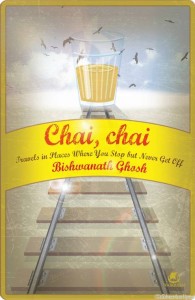Chai Chai is the first book by the author of Tamarind City. And you can see that the author Bishwanath Ghosh has grown in his writing from first to the second book.
Railway Junctions
I love the subject of the book. Railway junctions or the cities that are hubs for trains crisscrossing through them. These small towns are known only for the giant railway junctions that they have. Many passengers cross them, stroll on their platforms and move on. They never step out of the railway station. So the only image they carry of these places is that of the interior of the railway station, or the platform to be precise. Some of these towns have emerged around the railways. With a large portion of the population being railway employees living in their colonies. And the rest of the town kind of servicing them along with providing a service backbone to a station.
The author takes this unique journey to these towns surrounding the famous railway junctions in North India and some in South India. In the North he covers Mughal Sarai, Jhansi, Itarasi and in South he visits Guntakal, Arakkonam, Jolarpettai & Shoranur. The bulk of the book talks about the North Indian towns. And I think that is also because they are the bigger junction handling many more trains and hence passengers. In each of the towns, he finds the railway station as the epicenter of activity.
Pattern
The author follows a pattern where he lands in the station. And then tries to locate a hotel around it, which becomes a story in itself. As it tells a lot about the town. And brings out the sharp contrast with the established cities. He walks into the by lanes of these towns, gorges on the street food while explaining the scene of the food to you. And tries to talk to a people on the street and extract stories of the place. He tries to locate any old heritage building that may exist. And if he finds one, he tries to see if there are any stories the place has to tell. Invariably every place has some stories, some historical connection.
In the process, he ends up meeting old men in town. Who have seen say pre-independence days or have played some small part in its history. He tries to figure out how the place got its name. A kind of question that people of the city/towns probably have never bothered to ask themselves or their ancestors.
Journalist Card
Journalist card and contacts help the author in each of the places. But I guess it is his inquisitiveness that makes all the difference. His ability to share his own stories from his childhood and his habits while traveling bring in the personal touch to the travelogue that would otherwise be very dry and bland. The curiosity that takes him to strangers table or invites someone to his table in a restaurant or a bar for the sake of company as well as tales of the town.
Between the two sections, he brings out the contrast between South Indian towns and North Indian ones. Former being cleaner and their people being more predictable, but not as vibrant. He talks about his feeling at home when he meets a Tamil tourist group in Jhansi. An emotion that I completely connect with as a North Indian living in South India.
Not as polished as his second, still a unique kind of journey that takes you to towns you have heard, you have stepped foot into but never bothered to see beyond the station, makes Chai Chai an interesting read.
Buy Chai Chai: Travels in Places Where You Stop But Never Get Off by Bishwanath Ghosh at Amazon.









